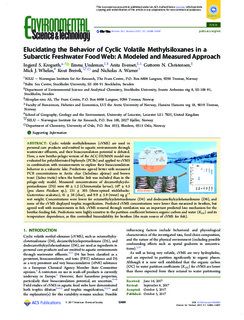| dc.contributor.author | Krogseth, Ingjerd Sunde | |
| dc.contributor.author | Undeman, Emma Maria | |
| dc.contributor.author | Evenset, Anita | |
| dc.contributor.author | Christensen, Guttorm N. | |
| dc.contributor.author | Whelan, Mick | |
| dc.contributor.author | Breivik, Knut | |
| dc.contributor.author | Warner, Nicholas Alexander | |
| dc.date.accessioned | 2017-11-14T10:13:57Z | |
| dc.date.available | 2017-11-14T10:13:57Z | |
| dc.date.created | 2017-10-09T11:25:50Z | |
| dc.date.issued | 2017 | |
| dc.identifier.citation | Krogseth, I. S., Undeman, E. M., Evenset, A., Christensen, G. N., Whelan, M. J., Breivik, K., & Warner, N. A. (2017). Elucidating the behavior of cyclic volatile methylsiloxanes in a subarctic freshwater food web: A modeled and measured approach. Environmental Science & Technology, 51, 12489-12497. doi:10.1021/acs.est.7b03083 | nb_NO |
| dc.identifier.issn | 0013-936X | |
| dc.identifier.uri | http://hdl.handle.net/11250/2466112 | |
| dc.description.abstract | Cyclic volatile methylsiloxanes (cVMS) are used in personal care products and emitted to aquatic environments through wastewater effluents, and their bioaccumulation potential is debated. Here, a new bentho-pelagic version of the ACC-HUMAN model was evaluated for polychlorinated biphenyls (PCBs) and applied to cVMS in combination with measurements to explore their bioaccumulation behavior in a subarctic lake. Predictions agreed better with measured PCB concentrations in Arctic char (Salvelinus alpinus) and brown trout (Salmo trutta) when the benthic link was included than in the pelagic-only model. Measured concentrations of decamethylcyclopentasiloxane (D5) were 60 ± 1.2 (Chironomidae larvae), 107 ± 4.5 (pea clams Pisidium sp.), 131 ± 105 (three-spined sticklebacks: Gasterosteus aculeatus), 41 ± 38 (char), and 9.9 ± 5.9 (trout) ng g-1 wet weight. Concentrations were lower for octamethylcyclotetrasiloxane (D4) and dodecamethylcyclohexasiloxane (D6), and none of the cVMS displayed trophic magnification. Predicted cVMS concentrations were lower than measured in benthos, but agreed well with measurements in fish. cVMS removal through ventilation was an important predicted loss mechanism for the benthic-feeding fish. Predictions were highly sensitive to the partition coefficient between organic carbon and water (KOC) and its temperature dependence, as this controlled bioavailability for benthos (the main source of cVMS for fish). | nb_NO |
| dc.language.iso | eng | nb_NO |
| dc.title | Elucidating the Behavior of Cyclic Volatile Methylsiloxanes in a Subarctic Freshwater Food Web: A Modeled and Measured Approach | nb_NO |
| dc.type | Journal article | nb_NO |
| dc.type | Peer reviewed | nb_NO |
| dc.description.version | publishedVersion | nb_NO |
| dc.rights.holder | Copyright © 2017 American Chemical Society | nb_NO |
| dc.source.pagenumber | 12489-12497 | nb_NO |
| dc.source.volume | 51 | nb_NO |
| dc.source.journal | Environmental Science and Technology | nb_NO |
| dc.identifier.doi | 10.1021/acs.est.7b03083 | |
| dc.identifier.cristin | 1503302 | |
| dc.relation.project | Norges forskningsråd: 222259 | nb_NO |
| dc.relation.project | Norges forskningsråd: 244298 | nb_NO |
| cristin.unitcode | 7460,60,0,0 | |
| cristin.unitcode | 7460,57,0,0 | |
| cristin.unitname | Miljøkjemi | |
| cristin.unitname | Atmosfære og klima | |
| cristin.ispublished | true | |
| cristin.fulltext | original | |
| cristin.qualitycode | 2 | |
